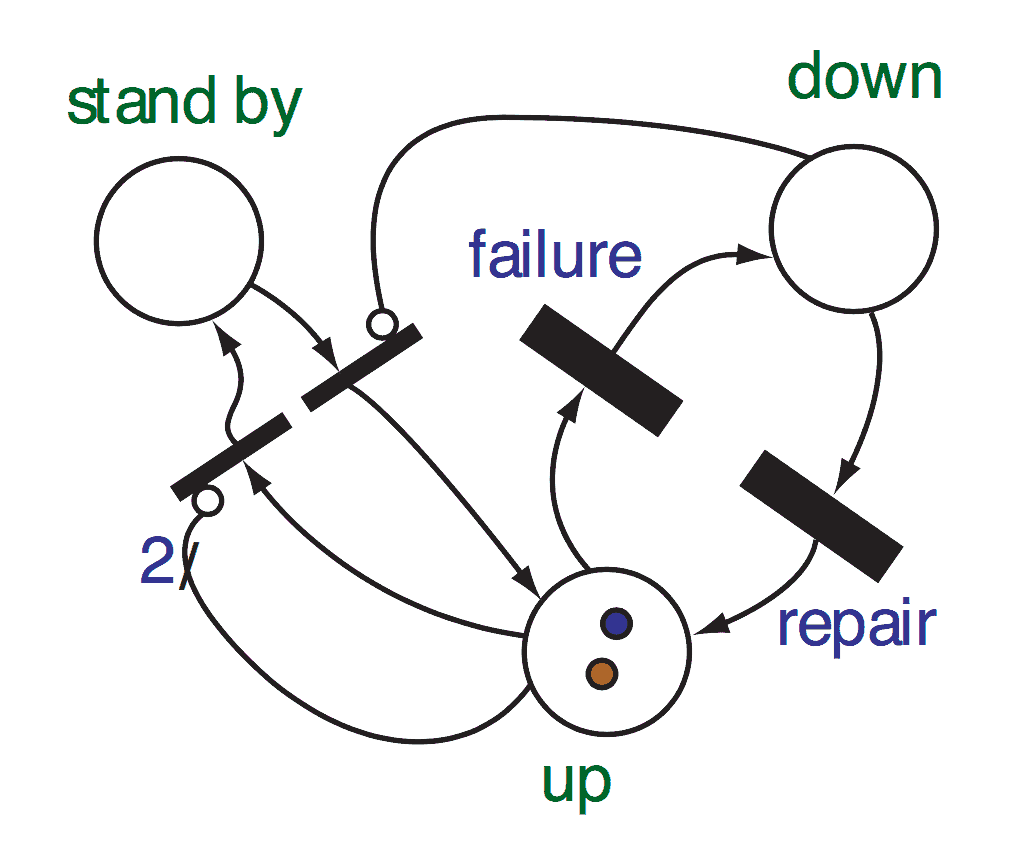
A Petri net graph is a depiction of a system using a symbolic language.
The modeling permits the analysis of complex systems or networks of systems.
It is possible to include elements of the system that are neither function or failed. In other words, it permits modeling a system when one or more of the elements are in a degraded state or under repair.
Petri net modeling is useful when the repair/restore times are long compared to operating times, as reliability block diagrams and fault tree analysis approach assume short or insignificant repair times, in most cases.
Petri net modeling permits mathematical analysis of system functionality along with system reliability.
There are a range of types of Petri nets useful for reliability modeling including:
- Stochastic Petri-Net (SPN) which includes a firing time with each transition. The firing of a transition creates a change in of state of the associated elements.
- Generalized Stochastic Petri-Net (GSPN) permits timed transitions with a mix of zero firing times and exponentially distributed firing times.
- Extended Stochastic Petri-Net (ESPN) with arbitrary statistical distributions of firing times.
Basic terms and elements of Petri nets
Transitions or the events that may occur are represented by bars.
Places or conditions are represented by circles.
Arrows or Arcs (flow relations) describe the flow of information between transitions and conditions. Arcs do not connect transitions to transitions, nor conditions to conditions.
Tokens are dots within Places which represent a specific configuration of the net called a marking. As the network experiences transitions, the tokens move across the model.
Here is a simple Petri Net example [Volovoi, 2004]


The two tokens, dots, represent two units in the system. The three circles, places, present the three possible states each unit finds itself: Up or operational; Standby or ready and not operating; or Down meaning the unit is not operational or failed.
The transitions, the bars, contain information on the timing and frequency of moving between states following the various arcs.
Modeling tools
It is beyond the scope of this work to fully describe Petri Net modeling other than this brief mention. The modeling of complex systems is often done using computer modeling tools.
The site, Petri Nets Tool Database list numerous software tools for modeling.
https://www.informatik.uni-hamburg.de/TGI/PetriNets/tools/db.html
Kishor Trivedi has a YouTube lecture on Stochastic Petri Nets
Kishor Trivedi on Stochastic Petri Nets – YouTube
https://www.youtube.com/watch?v=V43izsrnKbw
Volovoi V., RAMS 2004 – International Symposium on Product Quality and Integrity. 2004. “Modeling Multiphased Missions Using Stochastic Petri Nets with Aging Tokens.” Proceedings – Annual Reliability and Maintainability Symposium 2004-January (January): 232-236.
Andre Kleyner sent the following note with a few more basic references on Petri Nets:
I’m glad you brought up the topic of Petri Nets on Accendo. I actually co-authored a couple of articles with Vitali Volovoi on Petri Nets:
Kleyner A., Volovoi V. (2010) Application of Petri Nets to Reliability Prediction of Occupant Safety Systems with Partial Detection and Repair, Reliability Engineering and System Safety v.95 June 2010, pp. 606-613
Kleyner A., Volovoi V. (2008) Reliability Prediction using Petri Nets for On-Demand Safety Systems with Fault Detection. Safety and Reliability and Risk Analysis. Edited by Martorell, Soares, and Barnett. Proceedings of ESREL (European Safety and Reliability Conference), v.3, pp.1961-1968.
Also in Practical Reliability Engineering Ed.5, I added section 6.12, which is dedicated to Petri Nets basics with an example
you’ve just saved my life ! I love u !
Glad to help Shorouq.
Cheers,
Fred
Interesting stuff , thanks a lot Fred for your qualitative topic , long time after been graduated I started reviewing Markov and discovering Petri networks since the past 03months ,As I am actually working on the obsolescence of ICSS in different area I feel missing all that time for re-studying classical ideas related to the reability of the ICSS and how better can enhance their availabilities in the O&G .I would like keeping contact with you for further subjects or projects thank you ; you may contact me on. mezdir@yahoo.fr